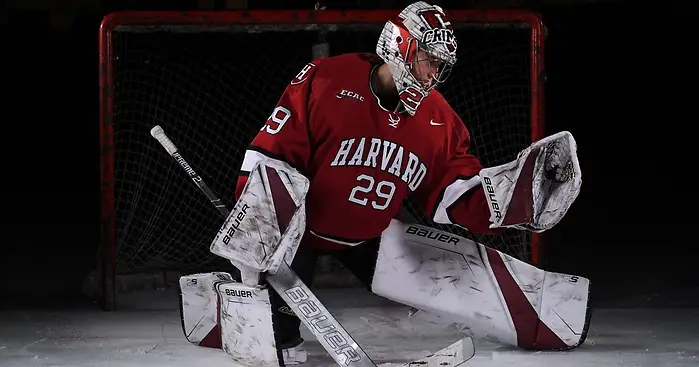
Nicole: We finally had a full slate of games as the Ivies started their schedule and we were able to get a look at all the top teams this week.
Arlan: The Ivies offer something for everyone. A couple of teams trying to get better who have some ground to make up: Brown and Dartmouth. A couple of teams looking to make the postseason: Yale, who has a decent chance because other teams have even greater problems; and Harvard: a squad that was perennially in the hunt for conference titles, but apparently, no longer. Meanwhile, Cornell and Princeton have occupied the power vacuum that Harvard’s decline left behind.
Nicole: It’s become pretty clear that there are more questions than answers in Potsdam right now, as Clarkson had another weekend where they struggled against an opponent they should have beaten. Their 5-1-2 record doesn’t really tell the complete story.
Arlan: If you look at the series versus Lindenwood in totality, then the Golden Knights did fine, outscoring the Lions, 8-1. The problem was that only one of those tallies came in the opening 65 minutes, when they did out-shoot the visitors by more than two to one.
Has everything gone to Clarkson’s liking thus far? No, but I’m not going to cast any aspersions its way, at least not in October. For one, Matt Derosiers is still trying to sort out his goaltending. Marie-Pier Coulombe sports the better save percentage and goals against average, but Amanda Zeglen is unbeaten in the early going. Clarkson added three senior forwards to last year’s lineup. Caitrin Lonergan got hurt in the opener and hasn’t played since then. Rhyen McGill was injured in that game and has been limited to five games, as has Kayla Friesen. So the Golden Knights haven’t gotten the type of boost that they might have hoped from three veterans who can provide some punch.
If you’re not liking Clarkson to this point, what has impressed you in the ECAC?
Nicole: I’ll reserve any blanket comments until we’ve seen a few more games, but Cornell handled Robert Morris in a way both Minnesota and Clarkson could not. Seems we might have underestimated the Big Red and they should be further up the rankings. The focus is usually on offense, but a big story for Cornell again this season will be their defense. They returned all six members of their blue line corps and even though they have to replace Marlene Boissonault in goal, it may not matter all that much. The defense gives whichever goalie they go with a huge cushion and allows them to settle in.
Arlan: Speaking of the goalies, Doug Derraugh has quite the range of heights from which to choose. Sophomore Kaity McKenzie is 6’ 3” and stopped the only shot she saw last year. Junior Ally Dalaya is 5’ 10” and has never played for Cornell. Lindsay Browning is only 5’ 3”, but who cares when she is stopping everything that gets through that defense that you mentioned. I’m guessing that Derraugh gives Browning the nod most of the time.
Nicole: The big surprise for me this weekend was Providence’s win over Northeastern. The win itself is a big one, but so is holding the Huskies scoreless. They outshot the Friars 33-20, but could not find the back of the net. Providence is relying on goalie Clare Minnerath, who has little collegiate experience prior to this season and I’m impressed with her play so far. We know Hockey East is tough and the separation from top to bottom is as narrow as it’s ever been, but I still found this a surprising loss for Northeastern.
On the other hand, Boston College is looking better than I’d expected. They look crisp and fast and are playing well and winning the games they should be winning – something they’ve struggled with in recent years.
Going into this season, I thought this was Northeastern’s conference to lose, but now I’m thinking it’ll be more of a fight to the finish than I anticipated.
Arlan: Ah, Hockey East. I’m trying to remember if that league singlehandedly was the inspiration for me banishing myself from the picks contest, or if it collaborated with the CHA. Either way, anytime that I think I’m getting a handle on where teams stand, one of those New England squads is bound to do something that forces me to rethink the meaning of life.
Yes, Minnerath was impressive in blanking the Huskies, but it took New Hampshire just 96 seconds to snap her shutout string the next day, and the Wildcats’ offense kept going in a 6-2 beatdown of the Friars. We’ve written that UNH looks to be improved, but it’s a pattern that is often repeated by teams that are jockeying to break into the at-large picture. An impressive upset is soon followed by a demoralizing loss to a lower-ranked team.
The Eagles suffered their first blemish of the campaign, salvaging a 3-3 tie on home ice versus Maine on a late goal by Hannah Bilka. The Black Bears were coming off a convincing, 3-0, win on the road at UNH, but prior to that had only scored twice in a three-game stretch.
It’s Hockey East. I don’t know what is going to happen, but I promise you that it will be something that I didn’t see coming. For example, I thought that BC was the class of the conference, and it started out 7-0, but five of those wins were over rebuilding Merrimack and still-building Holy Cross. The other wins are over Syracuse, a team that’s played a tough non-conference schedule and made it look even tougher in starting off 0-9, and Vermont. The Catamounts might be resurgent, but do we really know?
Will we get any answers when BC hosts UNH and Providence this weekend?
Nicole: BC made me have regrets about writing that bit about them before they finished playing on Saturday. Go figure. I should know that I spend the whole season watching games and highlight videos trying to get a read on each team and the moment I feel like I’ve got something figured out, those teams do something to turn it all upside down.
You mentioned giving up on picks – I’m definitely not sad that I’m not competing or keeping track of game picks this year. It was hopelessly demoralizing to have that stark reminder of feeling like I have no idea what’s going on. In a larger sense, I love the chaos and that teams are constantly getting better and surprising us. It’s good for the game and it’s great for the future of the sport. But as someone who tries to cover Division I as a whole and sort of distill it down to share with others, it’s so frustrating. Sometimes I have to remind myself this is fun.
All of that is to say that I don’t feel like I have any idea what will happen with BC against UNH and Providence. Not in the slightest. I’m very wary of believing that Boston College will respond to a disappointing outing by picking it up a notch after last season when we said we thought they’d do that time and again and they never really did. Both Providence and UNH are teams they lost to last season, as well, and both have improved since then, I believe.
You mentioned Harvard and their recent struggles earlier. Do you think we will see the Crimson return to prominence any time soon? They did put seven goals in on Friday, but they also took until well into the third period to really put away Dartmouth. I really like Lindsey Reed in net, but I’m not sure that’s going to be enough for them to build from.
Arlan: I’m having difficulty adjusting to the new reality concerning Harvard. For the first decade of a national tournament, Harvard was the most consistent power in the East, winning an AWCHA championship and finishing second in the NCAA for three straight years. Those teams featured some of the best offensive players in the country: A.J. Mleczko, Jennifer Botterill, Angela Ruggiero, Nicole Corriero, Julie Chu, Sarah Vaillancourt. Obviously, Ruggiero played defense, but she could rack up points with the best of them.
What those Harvard teams often lacked was elite goaltending, and if they did have a promising goaltender, she’d battle injury problems. Finally, Katey Stone did get a top-tier goalie in Emerance Maschmeyer, who got the Crimson back to the title game in 2015, but by then, the offensive firepower wasn’t the same. Leading scorers career totals resembled what stars in Harvard’s glory days posted in a season.
Two years after their most recent runner-up finish, the Crimson managed only five wins, a number that they used to routinely achieve in the postseason alone. In the aftermath of that collapse, I have no clue as to where Harvard is headed. It used to battle Brown and Dartmouth for the pinnacle of the Ivy League and the entire ECAC. When the Bears and the Big Green declined, they never made it back to the top. The Crimson don’t seem destined for the bottom third of the ECAC, but neither do they look like they’re ready to contend with Clarkson, Cornell, and Princeton for the top.
I think that Colgate is at least a year away from being a serious threat in the ECAC and nationally; the Raiders have talent, but most of it is unproven. I’d lump Harvard in a group with Quinnipiac and St. Lawrence. While each has potential to move up a bit if things unfold optimally, they will likely be road teams for the ECAC quarterfinals.
Speaking of the Saints, freshman forward Anna Segedi is off to a nice start, averaging 1.5 points per game. Of the rookies who have been in action for a month, only BC’s Hannah Bilka and Gabrielle David of Clarkson are scoring at a higher rate. Have you seen enough of these or other freshmen to hazard a guess as to whom will be the scoring leader for that class by season’s end?
Nicole: One dark horse pick might be Brooke Bink at Ohio State, who doesn’t have quite the same numbers yet, but who is also finding a prominent role on a team that could use some more scoring threats to take the heat off Emma Maltais. At this moment I’d go with Bilka, though if the injuries Clarkson has end up eating up more of the season, I may change my mind. She gets my vote over Segedi simply because the Saints aren’t as high-scoring an offense.
One of the reasons I wouldn’t pick David is just that there’s so much other fire power on her team that I think she could be relegated to a less prominent role. That’s not to say that there’s not talent at BC, I just think Bilka has solidified her role already and I don’t see her being shifted off that top line. Her position in that offense is very clear and she’s found chemistry and success immediately.
Looking ahead, next weekend brings some great top-10 matchups with Northeastern at Boston University and Princeton at Cornell, but the highlight is the repeat of last year’s national championship game and a meeting of the top two teams in the country as Wisconsin travels to Minneapolis to face Minnesota.
I have a hard time imagining anything other than a split every time these two play as the margins are usually super thin. Statistically, they’re very similar, in most every category but the power play. Wisconsin has been ridiculously prolific with the player advantage, scoring at a nearly 50% rate, though they were 0-for-5 against Bemidji last weekend.
Wisconsin has succeeded so far by moving quickly through the neutral zone, moving the puck quite a bit and being aggressive on the forecheck, all things the Gophers will make it difficult for them to do with any regularity. If a Wisconsin/Minnesota game guarantees one thing, it’s that no one will hold possession very long. The games are chippy and disruptive because they know each other’s style so well. The winner is usually the team that can adapt to that and not be flustered by being pushed out of their comfort zone.
Have you seen anything from either team so far that makes you think one is more likely to sweep? What have you seen from Minnesota that gives you a feeling how they’ll handle this weekend’s Border Battle?
Arlan: If there is to be a sweep, I think that most people would look to the Badgers, who come in riding a 17-game winning streak that dates back to last season and they are unbeaten in their last 24 contests. Wisconsin is No. 1 for a reason, or more likely, many reasons. In defeating Minnesota in the championship games of both tournament meetings in March, the Badgers took advantage of turnovers midway through the first period to grab a lead that they wouldn’t relinquish.
So it figures that the start will be crucial, and that’s not a particular area of strength of late for the Gophers. After starting quickly in their first two series, taking leads in each first period that they’d expanded to multi-goal leads by the second intermission, five of Minnesota’s next six games have been tied at some point of the third period.
A quick glance at the statistics suggests that Wisconsin has the edge offensively, but I believe that is a mirage conjured by the Badgers drubbing Long Island University. Looking just at WCHA play, both teams have scored an average of nine goals per weekend. In league play, the Badgers have defended better, allowing just over two goals per series, while Minnesota yields three tallies every two games.
If we were to compare various categories of each team and hand out check marks, I’d say that the penalty kill to date has been even, with both kills yielding two goals while netting a shorthanded goal. I’d give Wisconsin the check for power play, goaltending, overall team defense from all six players as a unit, and forwards — thanks in large part to having the more prolific top line. Minnesota has a slight edge on the blue line, although its least-experienced duo just got abused for three goals in the loss to Ohio State. The Gophers also get an intangible check for being the home team and having more to prove.
Maybe we just ignore the previous paragraph because one can’t use the check in women’s hockey? Anyway, you’re probably right that it will be some sort of split. Perhaps we’ll get to see how the premier rivalry in the sport of late handles a three-on-three overtime.


